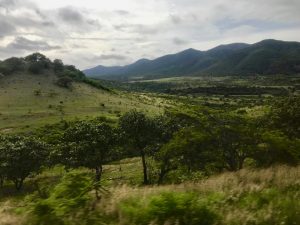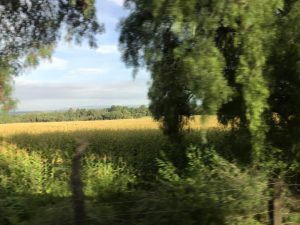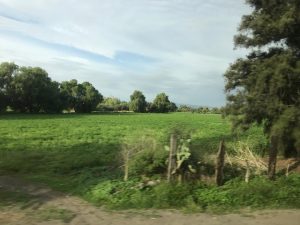The hills are alive with the color green. And the fields too. Now that the rains have finally arrived here in the central mountains of Mexico, the brown, dormant earth has woken up and erupted in tufts of green. Everywhere you look, except for the rocky outcrops and ravines, is covered in green.

From my window seat on the Primera Plus bus from San Miguel de Allende to the capital city Guanajuato the other day, I could see, when the bus drew close enough, green sprouts emerging from the fields’ vast, tidy brown furrows. Elsewhere, from a distance, I could see that the corn fields – to paraphrase a line from the show “Oklahoma!” – were as high as an elephant’s knee:
Scenes like this are thrilling to me. They bring back vivid memories of my years in southern Africa when I was in my mid-twenties, working at a weekly farming magazine in then-Salisbury, Rhodesia, now Harare, Zimbabwe. This was more than fifty years ago, at a time when Rhodesia was a breadbasket for Africa.
At that time, while visiting the outlying farms from my office in the capital, I fell in love with the sight of chocolatey soil, neatly furrowed fields, and healthy, hope-filled green plants reaching for the sun, as far as the eye could see.
While others on the bus to Guanajuato dozed or communed with their smartphones, I was glued to the passing verdant vista, taking too many blurry photos of Mexico’s breathtakingly beautiful, undulating mountainous middle, now dressed all in green:
Perhaps if I’d been raised on a farm or a ranch, I’d find such scenes ho-hum. But growing up in northern New Jersey, in the New York Metropolitan Area, and having lived in a studio apartment on the fifth floor of an Upper West Side building in New York City for two decades, the sight of immense fields of green still, after all these years, excites me:
But these, I realize, as I practically press my nose against the bus’s window pane, are more than pretty scenes. Agriculture is vital to Mexico’s economy.
According to Choices Magazine, a publication of AAEA (Agricultural & Applied Economics Association), Mexico is a major global producer and exporter of agricultural products, capturing a significant share of the total world exports of: citrus and melons, tomatoes, cucumbers, and tropical fruit, including pineapples, mangoes, avocados, and guavas. “The agriculture and food sector is one of the main engines of Mexico’s rural economy, representing 3.3% of its national gross domestic product.” (See below for a link to the full article if this interests you.)
As for the fields of corn I saw along the way to Guanajuato, I thought of the meaning this product has for the Mexican people. In Mexico corn is not only a commodity, it is something deeply rooted in the country’s culture and heritage and has been for over ten thousand years. In fact, Mexicans often refer to themselves as “children of the corn,” descendants of those whose religious beliefs included three corn gods. A close look will show that corn cobs appear throughout ancient – as well as current — Mexican art:

And how can we forget Mexican food? Corn forms the basis of the country’s diet. I learned that more than six hundred traditional Mexican dishes contain corn. And a Mexican friend told me recently that the average Mexican adult here eats no less than six corn tortillas at the family’s main meal each day.
Unlike that of the U.S., Mexico’s paper currency is not uniformly green. The 100-peso note, for example — all that I needed to take this beautiful bus trip — comes in a golden-yellow color and features a corn cob in the corner. So, it seems to me, metaphorically speaking, for Mexico maize is an everlasting currency; corn is more than just green.
~ ~ ~ ~ ~ ~ ~ ~
* For more information on Mexico’s agricultural sector, go to:





Wonderful images of your area awakening, Bonnie. Thanks for sharing!
Thank you — and you’re welcome, Lily! Hope all is well with you.
Another wonderful column!!! Thank you!
Thank you, dear Beth! I’m so glad you liked this post.
Beautiful meditation Bonnie, connecting the visual and the cultural with the sustenance. My friend Pepe painted a corn-crowned woman in Guanajuato, very close to the Diego Rivera museum. Maybe you saw it!
https://kimmie53.files.wordpress.com/2022/06/img_9490.jpg
Thank you, querida Kim! And I’m glad you added the link to your blogpost. I hope WOW readers will go to it to see Pepe’s mural. — xx
HI Bonnie – I loved your post this week. Greenery, countryside, open air, hills, crops – all so important to our spiritual well-being as well as our mental well-being. Too much city life, while exciting and filled with activity, depletes us and time spent in the countryside replenishes us. I hope one day, after I return to SMA, I can ride along with you and stare out the window.
Yes, Barb dear, it’s a date! (To take a bus trip together.) Thank you for your lovely response to this post. You’ve expressed so well for me why these bus trips replenish my soul.
Hi Bonnie. I used to spend summers on my grandparents farm where it was flat, but quite verdant, and I never quit finding it beautiful. I loved the trees, the cool shadow they made, and the moss that sporadically grew under them, the smell of the moist dirt after the morning’s dew, and the green. The many, many colors of green!
You are such a beautiful writer, Bonnie. I love reading your posts.
Thanks so much, Betty, for your kind words and for sharing your sweet memories of visits with your grandparents. I was hoping this post would prompt readers’ memories. Makes me happy.
How beautiful, la Bonnie! Viva el maíz. Lovely shades of green too.
Gracias, querida Te! Abrazos fuertes, BB xx
Dear Bon,
How beautiful your pictures are. And how I envy the verdant landscape, as New England enters a state of severe drought.
Love,
Paul
Oh dear, dear Paul — severe heat and drought are NOT what one normally associates with beautiful, lush New England. But these, as we all well know, are not normal times. Wish you were here! — BB xx
BonnieDear, like those of us in Taos who have said our blessings of gratitude practically every day for a month and a half and are now enjoying and appreciating uncustomarily green scenes wherever we go in town, I’m sure everyone there is happy and relieved that the rains came once again. Wish I could have seen it this green, but the weather was so perfect in March that I’ll never regret coming there at that time. xoxo ~ Be
I’m so glad to know that Taos is enjoying rainy weather — and the resultant greenery! Yes, people here, especially the farmers, I’m sure, are happy that the rainy season is here and everything is green. Green is such a life-affirming color! — xx
Hi Bonnie, I am new to your blog and enjoyed your story. What really intrigued me was your report of having lived in Africa. My husband and I are (finally) planning to go to Africa next summer. Delay was because of COVID, of course. Previously, we traveled independently to 50 countries in 5 years. Could you offer us any resources of how to travel Africa, other than the week-long, luxury Safaris? Thank you in advance. CarolSue Ayala
Hi, CarolSue — Welcome to my WOW blog! I wish I could help you with your travel plans, but I’ve been back from Africa for more than twenty years and things have changed a lot in that time. My most recent stay was in Mali, West Africa, which I would normally recommend highly for a visit; but the political situation there now would make it too dangerous for tourists. I understand (and empathize with) your wish to avoid luxury safaris. Finding alternatives, though, may take some research.
Well described about Corn’s deep culture in Mexico dear Bonnie.
Thank you so much! I enjoyed learning about it in doing my research for the post. Viva Mexico!